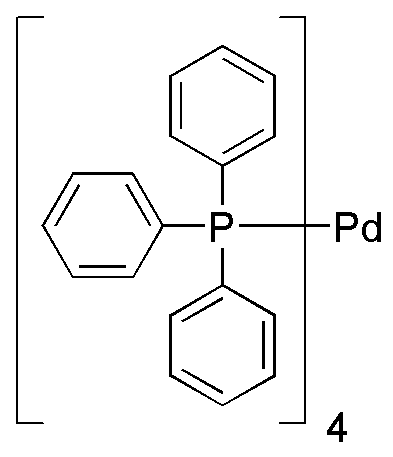Tetrakis(triphenylphosphine)palladium(0) is widely utilized in research focused on:
- Catalysis: This compound serves as a highly effective catalyst in various organic reactions, such as cross-coupling reactions. It enables the formation of carbon-carbon bonds, which is essential in synthesizing complex organic molecules.
- Pharmaceutical Development: In the pharmaceutical industry, it plays a crucial role in the synthesis of active pharmaceutical ingredients (APIs). Its ability to facilitate specific reactions helps streamline the drug development process.
- Polymer Chemistry: It is used in the production of advanced materials, including polymers. By enabling controlled polymerization reactions, it helps create materials with tailored properties for specific applications.
- Environmental Applications: The compound is also employed in the development of environmentally friendly processes, such as green chemistry initiatives. Its efficiency reduces waste and minimizes the use of hazardous substances in chemical reactions.
- Research and Development: In academic and industrial research settings, it is a valuable tool for chemists exploring new reaction pathways and mechanisms, contributing to the advancement of chemical knowledge and innovation.
General Information
Properties
Safety and Regulations
Applications
Tetrakis(triphenylphosphine)palladium(0) is widely utilized in research focused on:
- Catalysis: This compound serves as a highly effective catalyst in various organic reactions, such as cross-coupling reactions. It enables the formation of carbon-carbon bonds, which is essential in synthesizing complex organic molecules.
- Pharmaceutical Development: In the pharmaceutical industry, it plays a crucial role in the synthesis of active pharmaceutical ingredients (APIs). Its ability to facilitate specific reactions helps streamline the drug development process.
- Polymer Chemistry: It is used in the production of advanced materials, including polymers. By enabling controlled polymerization reactions, it helps create materials with tailored properties for specific applications.
- Environmental Applications: The compound is also employed in the development of environmentally friendly processes, such as green chemistry initiatives. Its efficiency reduces waste and minimizes the use of hazardous substances in chemical reactions.
- Research and Development: In academic and industrial research settings, it is a valuable tool for chemists exploring new reaction pathways and mechanisms, contributing to the advancement of chemical knowledge and innovation.
Documents
Safety Data Sheets (SDS)
The SDS provides comprehensive safety information on handling, storage, and disposal of the product.
Product Specification (PS)
The PS provides a comprehensive breakdown of the product’s properties, including chemical composition, physical state, purity, and storage requirements. It also details acceptable quality ranges and the product's intended applications.
Certificates of Analysis (COA)
Search for Certificates of Analysis (COA) by entering the products Lot Number. Lot and Batch Numbers can be found on a product’s label following the words ‘Lot’ or ‘Batch’.
*Catalog Number
*Lot Number
Certificates Of Origin (COO)
This COO confirms the country where the product was manufactured, and also details the materials and components used in it and whether it is derived from natural, synthetic, or other specific sources. This certificate may be required for customs, trade, and regulatory compliance.
*Catalog Number
*Lot Number
Safety Data Sheets (SDS)
The SDS provides comprehensive safety information on handling, storage, and disposal of the product.
DownloadProduct Specification (PS)
The PS provides a comprehensive breakdown of the product’s properties, including chemical composition, physical state, purity, and storage requirements. It also details acceptable quality ranges and the product's intended applications.
DownloadCertificates of Analysis (COA)
Search for Certificates of Analysis (COA) by entering the products Lot Number. Lot and Batch Numbers can be found on a product’s label following the words ‘Lot’ or ‘Batch’.
*Catalog Number
*Lot Number
Certificates Of Origin (COO)
This COO confirms the country where the product was manufactured, and also details the materials and components used in it and whether it is derived from natural, synthetic, or other specific sources. This certificate may be required for customs, trade, and regulatory compliance.


